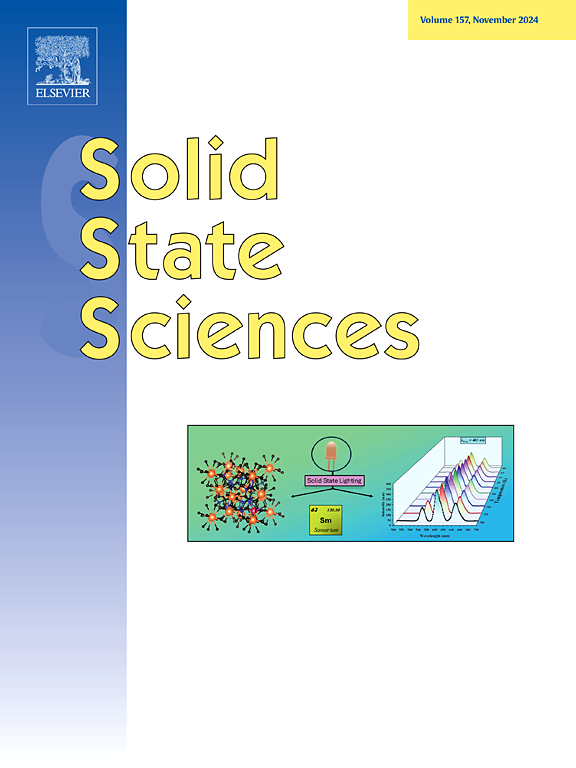Mo2Ta2O11的晶体生长、热、光、磁和电化学性能
IF 3.3
3区 化学
Q2 CHEMISTRY, INORGANIC & NUCLEAR
引用次数: 0
摘要
本文首次采用熔剂合成方法制备了过渡金属氧化物Mo2Ta2O11的单晶。化合物在三角空间群R 3中结晶,m (no。晶格参数a = b = 5.6267(1) Å, c = 25.1424(6) Å,单元胞体积为689.36(3)Å3。Mo2Ta2O11的结构是由ta6八面体和mo4四面体通过共享角连接而形成的交替层组成。用CaH2实现了Mo2Ta2O11的部分低温还原。本文还首次研究了多晶Mo2Ta2O11的电化学锂化过程。Mo2Ta2O11进行了结构重排,同时保持了约150 mAh/g的可逆容量。本文章由计算机程序翻译,如有差异,请以英文原文为准。

Crystal growth, thermal, optical, magnetic and electrochemical properties of Mo2Ta2O11
Single crystals of the transition metal oxide Mo2Ta2O11 were grown for the first time using molten flux synthesis. The compound crystalizes in the trigonal space group R (no. 166) with lattice parameters a = b = 5.6267(1) Å and c = 25.1424(6) Å and a unit cell volume of 689.36(3) Å3. The structure of Mo2Ta2O11 is composed of alternating layers of TaO6 octahedra and MoO4 tetrahedra connected via corner-sharing. CaH2 was used to achieve a partial low temperature reduction of Mo2Ta2O11. The electrochemical lithiation of polycrystalline Mo2Ta2O11 was also investigated for the first time. Mo2Ta2O11 underwent a structural rearrangement while maintaining a reversible capacity of ∼150 mAh/g.
求助全文
通过发布文献求助,成功后即可免费获取论文全文。
去求助
来源期刊

Solid State Sciences
化学-无机化学与核化学
CiteScore
6.60
自引率
2.90%
发文量
214
审稿时长
27 days
期刊介绍:
Solid State Sciences is the journal for researchers from the broad solid state chemistry and physics community. It publishes key articles on all aspects of solid state synthesis, structure-property relationships, theory and functionalities, in relation with experiments.
Key topics for stand-alone papers and special issues:
-Novel ways of synthesis, inorganic functional materials, including porous and glassy materials, hybrid organic-inorganic compounds and nanomaterials
-Physical properties, emphasizing but not limited to the electrical, magnetical and optical features
-Materials related to information technology and energy and environmental sciences.
The journal publishes feature articles from experts in the field upon invitation.
Solid State Sciences - your gateway to energy-related materials.
 求助内容:
求助内容: 应助结果提醒方式:
应助结果提醒方式:


